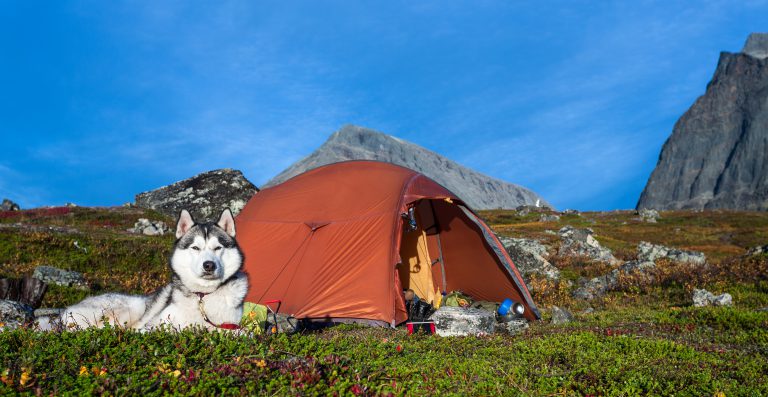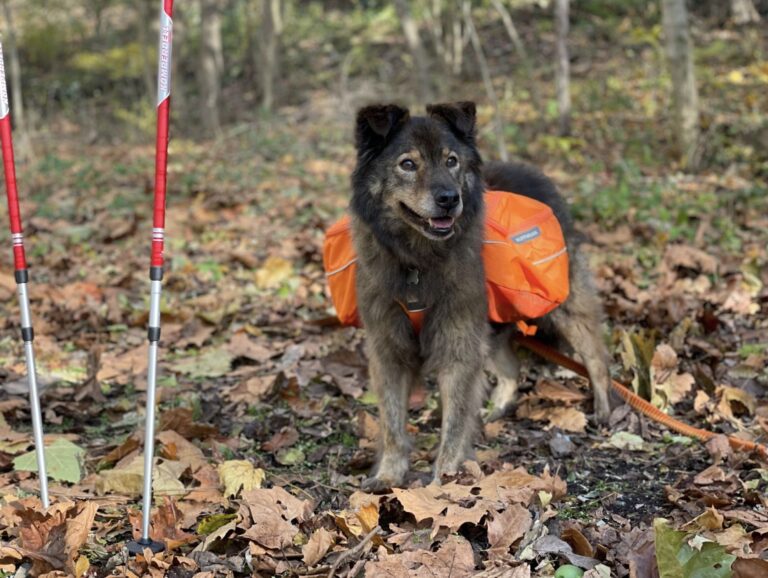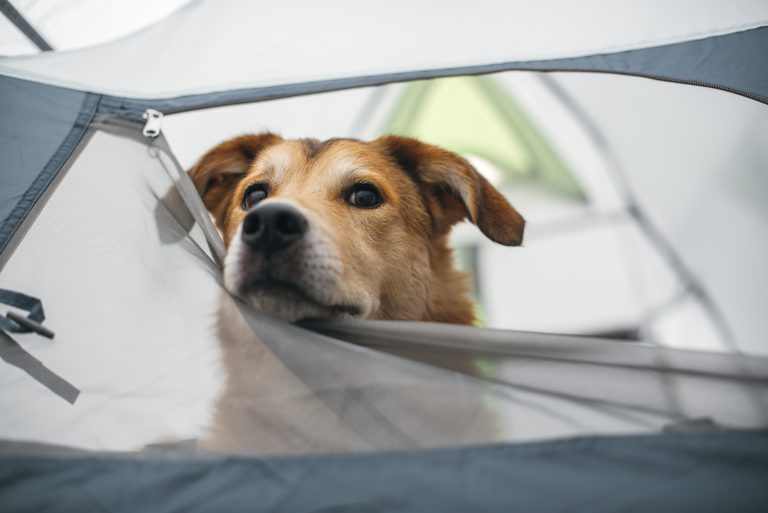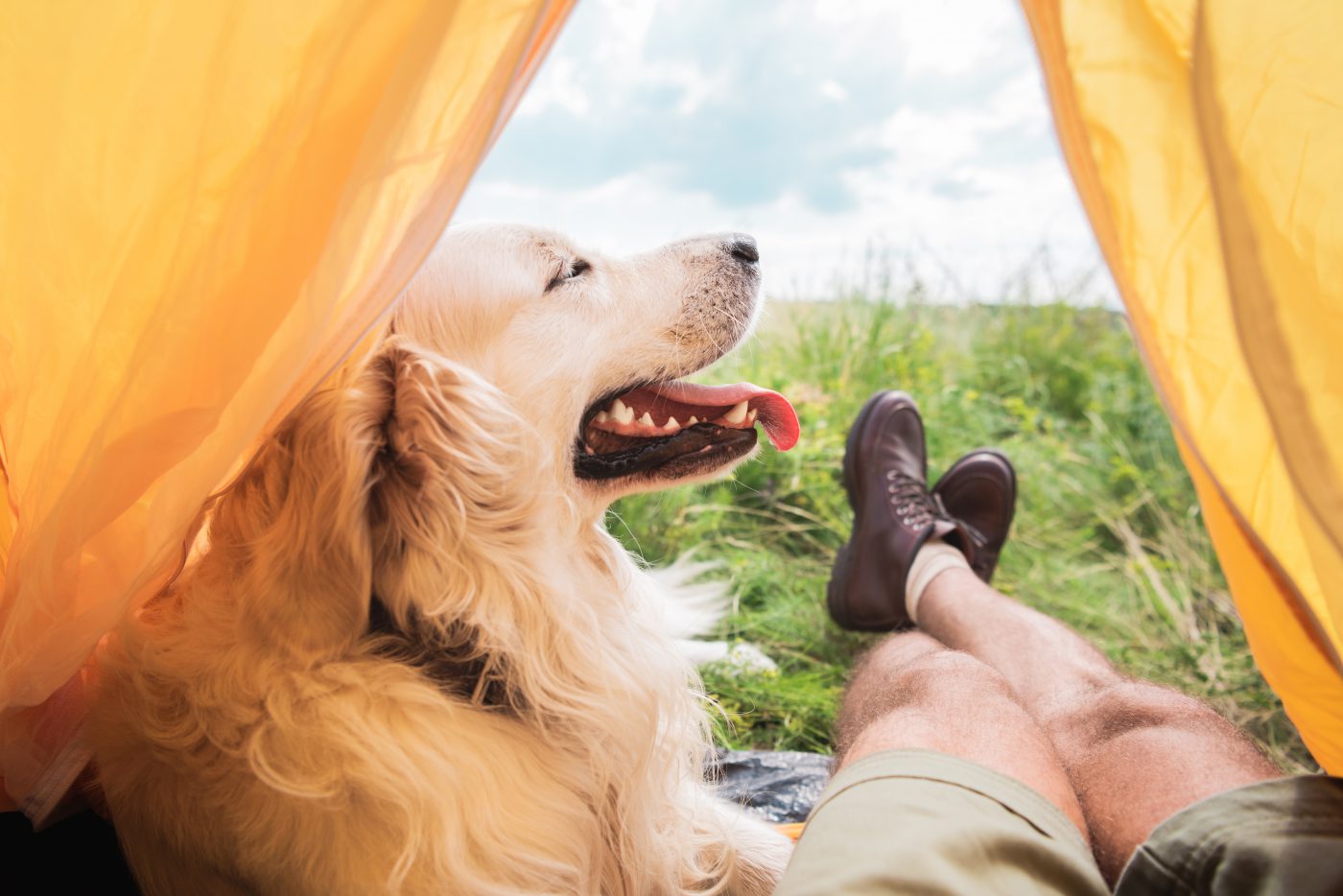If you love the outdoors, chances are you appreciate the wonder of spending a night or two under the stars, sitting around a campfire, subsisting on trail mix and boil-in-a-bag meals, and falling asleep to a cacophony of wild animals. The only thing that could make camping better is doing it with your dog.
Whether you want to glamp in style or bushwhack through backcountry, here is everything you need to know about how to camp happily with your dog.
The benefits of sleeping in the great outdoors
Camping isn’t just enjoyable—it’s good for you and your dog. When you spend time in a new place, it gives your dog some much-needed mental stimulation (new bed! so many new things to sniff!) while also giving them a sense of security, thanks to your presence. Research shows that dogs experience the “secure base effect, where the presence of an attachment figure allows dogs to more freely investigate novel objects.” Translation: with you there to monitor them, dogs feel safe enough to explore their new surroundings, which is essential to their mental well-being.
Furthermore, camping is good for their physical health (and yours). Just 30 minutes of exercise per day decreases the chances of obesity (a serious canine health crisis, with about half of American dogs reportedly being overweight or obese) and other health issues, such as heart disease, arthritis, and cancer.
What kind of camping can your dog do?

Not all dogs are suited to hiking several hours into the backcountry and roughing it, but that doesn’t mean they can’t still enjoy an overnight adventure in the great outdoors. For older puppies, senior dogs, dogs with medical conditions, and dogs whose body condition is not conducive to intense physical activity—and, hey, humans who just want to get outdoors for a few nights without lugging 30 pounds of gear on their back—there are numerous options.
Glamping: Glamping is exactly what it sounds like: glamorous camping, which comes with most of the trappings of a luxurious hotel stay. Though still technically a form of camping with lodging in a tent or tent-like structure, there are usually amenities like electricity, running water, and even air conditioning, so glamping is the type of camping best suited to brachycephalic (short-snouted) dogs and other dogs with limited mobility or extra sensitivity to heat and other inescapable conditions you’re likely to encounter while camping. This is also a great way to dip your toes into the world of camping.
Car camping: Some car camping facilities offer electricity and even bathrooms with running water and showers. Other forms of car camping fall on the more primitive side of things, providing just a flat campsite with room for a car or two, tents, and even a fire ring. Slightly less cushy but still allowing for you to bring as many comforts as necessary, car camping is great for older dogs, dogs with special diets that require refrigeration, and even dogs with mobility issues. You can bring a cooler (or three…), a dog bed, toys, and anything else your dog might need.
Walk-in camping: While you might be able to park close to your campsite, walk-in camping requires you to carry your gear to the site, so you might need to bring a lighter load than traditional car camping.
Backpacking: If your dog is in good shape, enjoys hiking (check out our guide to hiking with your dog for more information on how to get started), and is comfortable in a tent, backpacking might be the way to go. Backpacking takes a moderate amount of training, and most campsites are several miles from any trailheads, so only do this if your dog is already an experienced hiker.
The rules of the road (or, campsite)
Whether you’re camping on public lands or renting a slice of private property for the night, there are both written and unwritten rules to ensure your canine camp companion doesn’t disturb the wildlife or fellow campers.
Keep them on leash: Many campsites and parks that allow camping have strict rules about keeping dogs on leash at all times. Be sure to look up those rules before you go, and even if there aren’t explicit rules, still consider keeping your dog on a long lead to ensure they don’t wander too far from camp.
Keep them in sight at all times: An out-of-sight dog can often spell destruction and even danger. Unmonitored dogs can disturb or even kill wildlife, be attacked, or get into other sticky situations.
Leave only paw prints: One of the most important rules of enjoying the great outdoors is to leave no trace. Clean up after your dog, including, yes, their waste. If there aren’t trash cans or other receptacles designed for waste disposal around, either bury it, like you would with human waste, or pack it out. If you’re on a day-trip or other short camping trip, it’s best to pack your waste out. If you’re on a longer trip, dig a “cat hole” that’s more than 6 inches deep, and more than 200 feet away from a water source to bury poo. If other animals poop in the woods, you may ask, why can’t your dog? Because dogs eat a different diet than, say, deer and bears, and the chemical composition of their poop is different. This can have a negative impact on the environment, especially if the waste ends up in a water supply. Additionally, dog waste may contain pathogens that can harm wildlife.
What gear does your dog need?

Dogs, like people, need the right equipment to have a fun camping experience.
Non-negotiables
Collapsible food and water bowls: Collapsible bowls are the easiest way to make sure your dog has access to fresh water at all times and food at mealtimes. Put the food bowl away when not in use. Make sure the water bowl is lightweight, so you can take it with you on day hikes or any other adventures you and your pooch get into.
Sufficient food and drink: Bring enough food—and water, if you either won’t have access to potable water or don’t have a water filter— for your trip plus an additional day or two, just in case. Mistakes happen, after all. And if you’re planning on being active, make sure you pack upwards of 25% more calories than your dog’s usual diet, depending on how much exercise you’ll get.
If you feed your dog a fresh diet, it’s essential to keep the food cool to keep it safe for consumption. That means packing a cooler or other insulated container with plenty of ice to keep the temperature food-safe.
Make sure your dog is hydrated and isn’t tempted or able to drink from any natural water sources on the hike. Streams, lakes, ponds and the like can contain parasites such as leptospirosis and giardia, which can cause extreme gastric distress, or worse, in your dog. There’s another water-borne hazard you may encounter while camping: water with blue-green algae, also known as cyanobacteria. Prevent your pup from swimming in water that may be contaminated with blue-green algae as it’s extremely dangerous.
First-aid kit: Accidents happen, and it’s important to be prepared. Even if you’re at a drive-in campsite with electricity, or you’re glamping in style, be prepared for bug bites, paw pad injuries, and more with either a pre-made canine first aid kit (which you can get at specialty camping stores), or a homemade kit with a towel, hydrogen peroxide, antibiotic ointment or spray, gauze, a tick remover or tweezers, a soft muzzle, booties or small socks, and Benadryl in case of an allergic reaction or bee sting.
You should also take a recent photo of your dog (as if you don’t already have 1,000 of them in your camera roll) and keep a written record of their name, vaccinations, and your vet’s contact information. And of course, ensure your dog has their ID, in the form of a microchip and/or a collar tag.
A collar light: Keeping your dog safe means keeping track of them at all times, especially at night. There’s no shortage of clip-on lights and light-up collars on the market. You could also use a bike light, a headlamp, or any number of alternatives, just make sure you can keep an eye on your dog at all times.
Tick and mosquito repellent: Anywhere there’s greenery and wild creatures, there are ticks, and the diseases they carry pose a health risk to dogs and humans. Make sure your dog is up to date on your preferred tick preventative—speak to your vet about which one is right for your dog. While on your camping excursion, do a daily tick check on your dog—check their ears, paws, underarms, and everywhere else you can. If you spot a tick, remove it, carefully. Use a pair of tweezers or a purpose-designed tick remover to grasp the tick as close to the skin as possible. Don’t squeeze; instead pull up with gentle pressure. The goal is to remove the whole tick including the head and mouth parts (read more about tick removal here).
Mosquitoes can give dogs heartworm, so on top of your dog’s regular heartworm preventive, you might consider using a dog-friendly mosquito repellent. That means no DEET, which is dangerous for dogs. Some companies also make collars that have repellent in the fabric, but what you use is ultimately up to your preferences and your vet’s recommendation.
Nice-to-haves
A camp leash: When hanging out at the campsite, many people opt to put their dogs on a long lead, so pups can wander the site without leaving it and potentially getting into trouble. Many campsites in fact have leash requirements, so this is a way to make sure your dog gets a taste of freedom in a safe, above-board manner.
A sleeping bag or blanket: Depending on the season in which you’re camping, you may consider a dog sleeping bag or blanket, or, at the very least, a light layer between your dog and the tent floor. These layers not only keep your dog warm, they also reinforce that tent time means bed time. It’s a good idea to have your dog sleep on some kind of bed or blanket and not on the forest floor.
A chew toy or frisbee: Keep your dog active and engaged at the campsite. How you do that depends on their camp personality: if they require lots of mental stimulation, definitely bring a toy or two; if they’re content to sit around the site, and will likely be tuckered out and just want to rest from all the hiking, you can skip.
A backpack: If you’re hiking into your camping spot, it’s a good idea to let your dog carry their own gear.
How to prepare your dog for a night (or two or three) out in the woods

Tempting as it is to get out and go as soon as you decide to go camping with your dog, making sure the experience is fun and safe requires some preparation.
Tent training
Some dogs adapt to tent sleeping without much intervention. Others need extensive conditioning. Before heading to the campsite, pitch your tent in your home (or backyard, if you have one), and let your dog sniff around. Praise them for interacting with the tent, then slowly build their comfort by using treats and praise. Sit in the tent, door open, and call them in, praising them while they approach. Once they come inside, give them a treat, and then let them leave as soon as they want. You want to ensure they build positive associations in the tent.
Once they’re comfortable coming and going from the tent, start calling them in and practicing their sit, stay, lay down, and quiet commands, using effusive praise and plenty of treats with the tent door open. Once they seem relaxed performing these commands in the tent, start closing the tent door and working on their commands. If they whine or scratch at the tent, consider mat training outside of the context of camping/tent training, and then start practicing mat training skills in the tent.
“Leave it” and recall
We’ve said it before and we’ll say it again: strong recall and “leave it” skills can and do save dogs’ lives, and they’re essential to safe camping and hiking.
To prevent your dog from picking up inedible items strewn around campgrounds and hiking trails or harassing other animals (whether wildlife or other dogs), follow our step-by-step guide to building a strong “leave it.”
To prevent your dog from getting into other people’s or animals’ space and maintain a safe environment, practice recall skills as often as possible. If your dog does not have a strong recall, do not let them off-leash.
How to pack fresh food
If you’re car camping, you can put packs of fresh food in a cooler surrounded by ice. For shorter camping trips, you can store your dog’s food in an insulated bottle or two (for more tips, follow our guide to taking fresh food with you on the road.)
Once you’ve prepared your pooch for some quality time around the campsite, you’re all set to pack up and go. All that’s left is to sit back and relax to the sound of the forest.









